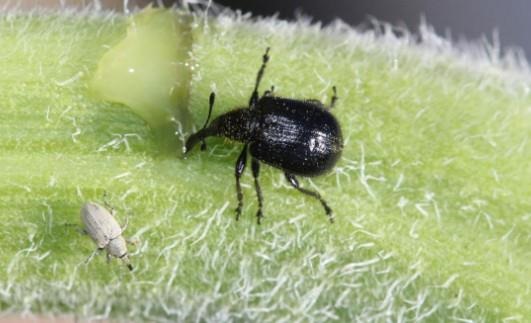Headclipping weevils have been active in some sunflower fields and in ornamental sunflower throughout South Dakota. Although the headclipping weevil is considered a minor pest of commercial sunflowers, it can cause a lot of problems for individuals trying to maintain sunflowers in their yards and gardens. The adults are active through July and August while the sunflowers are in the reproductive growth stages.
Their name comes from their activity on the sunflowers. The adult headclipping weevils will girdle (feed around the stem) the peduncle and leaf petioles (Figure 1). This feeding behavior results in the leaves or sunflower heads to either be completely clipped from the plant or be left hanging by the remaining plant tissue. In sunflower fields, the headclipping weevils usually only affect a small percentage of the plants and usually do not require management. Although most of the activity of the headclipping weevils is noticed on sunflower, they will feed on any plants within the Asteraceae family. In addition to sunflower, injury has been known to occur to flowers in the Silphium genus, specifically on coneflower, compass plant and prairie dock.
Identification

Figure 2. Headclipping weevil adult feeding on a sunflower peduncle.
Adult headclipping weevils are approximately 1/3 of an inch long. Their body is uniformly black in color and has a slight bronze luster, which is characteristic of the species (Figure 2). Like other weevils, they have an elongated snout with antennae originating near the base of the snout.
The larvae are cream-colored and will be C-shaped if observed. They have a light brown head capsule and will be present in the clipped heads. There is some speculation that the eggs that are laid on the clipped heads will only hatch if the head falls to the ground.
Scouting and Management
Scouting for headclipping weevils is relatively easy, as you are looking for sunflowers with clipped heads or leaves. While scouting a field, examine plants from random locations throughout the field. If 10% or more of the sunflower heads within the field are clipped and headclipping weevils are observed in the field, treatment should be considered. Unlike many of the other insect pests of sunflower, treatment should be targeted to the back of the sunflower head and not the flower face.
For issues in gardens, most of the injury will be aesthetic, and management is not recommended. If you observe a dangling flower head, remove it from the garden and destroy it, as it is necessary for the larvae to develop.
Source :